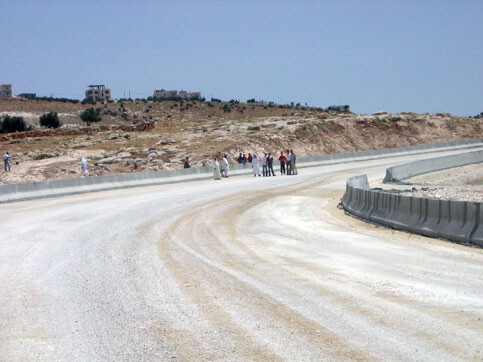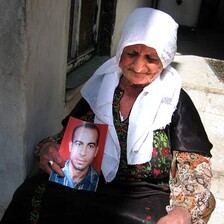The Electronic Intifada Ramallah 30 June 2005

A group of Palestinian men stand vigil in protest at the expropriation of their land, which is Israel is using to build a highway linking the settlement of “Har Homa” near Bethlehem in the occupied West Bank, to the settlement of “Teqoa,” further north. (Rima Merriman)
As with all dialects spoken by people who are close to the land in their daily cycle, the fallahee Palestinian dialect has a homely feel to it. Like the embroidered dresses that older fallahee women still wear in Palestinian refugee camps, villages and cities, this dialect, with its warmth and earthiness, is a national locus for a people whose identity the Zionist project in the Middle East has long tried to suppress.
The fallaheen make up the largest group of residents in Palestinian refugee camps, are the most disadvantaged economically, and are the most active group in Palestinian resistance organisations.
Fallahee is the dialect of the hearth, often associated with the nurture of a grandmother or with a basic heritage closely linked to austere values and to a simple but hard life. Many expressions in that dialect denote kinship both to localities and to people.
So imagine how dislocating it must feel for a Palestinian to walk into a machsom (the Hebrew for “roadblock” or “to stop”, now Arabised and used by Palestinians) to be deliberately and flawlessly addressed in this dialect by the foreign enemy who has long mangled the Arabic language.
This is the latest PR stunt by the Israeli army at Kalandia, where construction of a hi-tech border terminal is under way. Come 1 August, the Palestinian Jerusalemites who have managed to hold on to their IDs and who are now blithely going back and forth between annexed “Greater Jerusalem” and the West Bank will be officially cut off from the cycle of life in the West Bank — hospitals, family, work, schooling. They will need a permit for such movement, and speculations are rampant as to how much that permit will cost. Additionally, 30,000 Palestinians in Kafr Aqab and Kalandiya who hold Jerusalem IDs are now on the “wrong” side of the “Greater Jerusalem” border on which Israel is putting the finishing touches, and they will need special administration.
The man assigned the linguistic PR duty at the Kalandia checkpoint is middle aged and overweight, unlike the trim Israeli soldier boys and girls around him. Being unfit to stand physically for long as a soldier ought to, he sits in a chair and looks frumpy in his military gear. He uses this lulling flow of language to separate a male child from his mother, forcing the boy, as young as five or six, to go through the line reserved for men. “Ya khal,” [Oh, uncle] he calls to a Palestinian man in his 30s soothingly, “Go stand in that other line; this one is not for you.”
Oh, uncle! Do not be lulled. An independent national Palestinian state with Jerusalem as its capital is now impossible. Do not be pleased or relieved or flattered at the end of the day that you had been addressed in your own tongue instead of the rude, broken Arabic that labels every woman a “girl” and every man “a boy”. “Oh, uncle” certainly sounds and feels better, but it is a lie. You are no more their uncle than they are your cousins. The Israeli bulldozers have done their work too well.
There are no doubts left, none, not even wishful thinking, as to what Israel’s designs are and that these are backed by the US and that these will be forced on the Palestinians. Administrative refinements, hi-tech installations at terminals and checkpoints, smoother administrative operations — welcome as these might be in the daily lives of people who take two hours to traverse from a residence to a workplace just seven kilometres away (example: Kalandia to a school in Jerusalem) — are attempts to smooth the ugly surface of annexation and illegal settlement.
The contours of Israel’s expansion have been long in the making. After Sept. 11, these plans simply found their momentum. Take Bethlehem, for example, which is now isolated from its southern regions by the series of Jewish settlements in the Etzion Bloc. The settlement of Bitar Ellit, strategically built between the two Palestinian communities of Wadi Fukeen and Nahhaleen will soon reach the Hadassa area in the West, thus effacing the Green Line. The settlement of Kfar Etzion and all its branches south of Bethlehem extends to the mountaintops of Hebron. The settlement of Efrat blocks the road between Bethlehem and Hebron and also blocks Bethlehem from developing southwards. None of these sprang haphazardly.
Eastwards, there is the settlement of Teqoa, which is now being connected by a north-south highway to Har Homa (Jabal Abu Ghneim) settlement. At any given day, if you are passing on this road, you might see a desultory looking group of Palestinian men (oh, uncles!) whose lands have been confiscated clustering there in futile protest in the heat and dust of the yet-unpaved road, their olive groves cut down on either side. Fords full of Palestinian passengers routed from Kalandia to Bethlehem through a roundabout way on bad roads zip past them.
At the same time as blocking the expansion of Palestinian towns and villages, illegal Israeli settlements have immense expansion plans in place. The plans for Maale Adumim (with 30,000 settlers) nearly join it with the Jordan Valley and the Dead Sea. That’s a 15-fold increase in its population. The E1 plan, which is awaiting approval by the Israeli minister of defence, aims to settle the lands in the East between the Palestinian towns of `Anata, Az-Zi’ayyim and `Azariyyah, on one side, and the Maale Adumim Bloc, on the other.
Oh, uncle! It is already impossible to talk about a Palestinian state with Jerusalem as its capital or of a viable Palestinian state. What other realistic options are available do you suppose?





